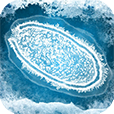Frozen Virus
| General Information Main Game - Cure Mode |
Strategy Guides Main Game - Cure Mode |
The Frozen Virus is an official scenario in Plague Inc., which involves the control of a virus dating back to the Neanderthal period frozen in the permafrost of Siberia, possessing the ability to spread and resist low temperatures as well as DNA repair to adapt to the modern world. It possesses the ability to invoke forced evolution in its hosts, causing them to "regress" to a more primitive state.
Its default name is Pithovirus in-game, after its eponymous real-life counterpart. It was introduced in Mutation 1.8 as a scenario for mobile devices.[1] It was later introduced to the PC as a beta build for Evolution 7 on May 20, 2014.[2]
Scenario Attributes
The plague starts with Amoeba 1, Mandibular Strain, Drooling and Cold Resistance 1 - 3 already evolved. The starting Country is automatically selected to be Russia. This is due to its in-game lore, as the Frozen Virus has been in the Siberian permafrost for over 30000 years.
Transmissions
- Bird 1 - 2: Birds become sources of contagion, increasing Infectivity, Land Transmission and Mutation.

- Insect 1 - 2: Insects become sources of contagion, increasing Pathogen's Infectivity, specially in Poor Countries, and Mutation.

- Livestock 1 - 2: Livestock animals become sources of contagion, increasing Infectivity, specially in Rural Countries, and Mutation.

- Rodent 1 - 2: Rodents become sources of contagion, increasing Infectivity, specially in Urban Countries, and Mutation.

- Water 1 - 2: Increases Pathogen's Infectivity, specially in Humid Climates and through Boats.

- Amoeba 1 - 3: By adapting host amoeba to spread and survive in many areas, it increases Infectivity in certain types of Countries. Specific stats vary with stage.

Symptoms
- Cysts: Painful lumps containing pockets of the pathogen. Slight chance of bursting which can spread disease

- Anaemia: Decrease in red blood cells or haemoglobin in the blood can lead to hypoxia in the organs

- Drooling: Occasional intemperate drooling when sleeping or eating. Increases infectivity slightly

- Memory Loss: Recent memories become nebulous in patients, replaced with vague historical recollections. Negatively impacts cure progress

- Skin Lesions: Breakdown in the epidermis causes large open wounds which significantly increase infectivity

- Jaundice: Accelerated viral reproduction in the liver results in bilirubin build-up, causing yellowing of skin, eyes and mucus membrane. Increases infectivity

- Mandibular Strain: Moderate pain in mastication muscles, especially when eating, and periodical jaw clicking

- Immaturity: Reduction in hormone levels causes immature and antisocial behaviour, reducing cure research. Lower levels of hygiene cause infection

- Abscesses: Pockets of infected flesh are painful and act as breeding grounds for the pathogen, increasing infection rates when burst

- Malignant Ascites: Accumulation of fluid in abdominal cavity due to severe cirrhosis. Can be lethal

- Edentulism: Severe gum infection causes teeth to fall out

- Aggression: Confusion and immaturity results in lethal primal aggression towards others. Cure progress significantly slowed

- Systemic Infection: Pathogen affects multiple organs and tissue types, causing body-wide infections that spread fast and can be fatal

- Tumours: Pathogen disrupts cell growth pathways, causing uncontrolled, eventually fatal tumour growth

- Hepatic Failure: Chronic replacement of normal liver cells with scar tissue causes liver to fail, resulting in rapid death

- Bone Dysplasia: Relentless bone growth with high mineral density results in severe musculoskeletal stress - lethal in many cases. Broken skin increases infection

- Carnivorous Denticulation: Hormone changes trigger growth of carnivorous teeth and consumption of raw meat. Poor dental hygiene increases infectivity

- Aphasia: Progressive loss of brain cells damages parts of brain responsible for language and understanding. Makes cure development harder

- Hemorrhagic Shock: Severe loss of blood volume causes oxygen deprivation, loss of consciousness and death

- Cranial Elephantitis: Increased bone growth places pressure on the brain. Trauma makes cure development significantly harder and can be lethal

- Neanderthal Regression: DNA recombination destroys logical and emotional brain function, leading to complete regression to Neanderthal state

Abilities
- Ice Resistance: Pathogen able to survive and spread in crystalline sea water when ice melts. Increases infectivity by sea, and is harder to cure

- Heat Resistance 1 - 3: Pathogen evolves to resist hot temperatures, which increases Infectivity in Hot Climates.

- Cold Resistance 1 - 3: Pathogen evolves to resist cold temperatures, which increases Infectivity in Cold Climates

- Drug Resistance 1 - 2: Allows the Pathogen to resistant treatments against it, increasing Infectivity in Rich Countries.

- Genetic ReShuffle 1 - 3: Pathogen reassembles its DNA or creates new strains, increasing the work required for a cure.

- Genetic Hardening 1 - 2: By making the pathogen harder to analyze in laboratories, it lowers the Cure Research Speed.

- DNA Repair 1 - 5: Through the regeneration of the Virus' DNA, it adapts to modern environments and unlocks more Abilities and body-altering Symptoms.

- Full DNA Repair: Viral DNA fully reconstructed, giving access to entire genetic code from Neanderthal era. Can now entirely reshape human temperament

Tips
- If the player wants all symptoms available, they should focus on the DNA repair trait first.
- Neanderthal Regression can be used to cripple cure efforts.
- Since the virus begins in Russia, players should plan out their strategy to reflect the sea traffic of Russia.
- The virus is already by nature highly resistant to cold climates, saving you significant amounts of DNA for other traits such as the Heat Resistance abilities it lacks.
Achievements

|
Achievement Name: | Complete Frozen Virus | ||||
| Achievement Description: | Score 3 biohazards the Frozen Virus scenario | |||||
| Value: | Difficulty: | Any | ||||
References
- ↑ Nelson, Jared (2014-04-22). "New ‘Plague Inc.’ Update Adds Mega Brutal Difficulty, New Cheats and New Scenarios". TouchArcade Retrieved on December 19, 2023.
- ↑ James (2014-05-20). "Beta Build - Evolution 7 - new cheats, scenarios and languages". Steam Discussions Retrieved on December 29, 2023.

